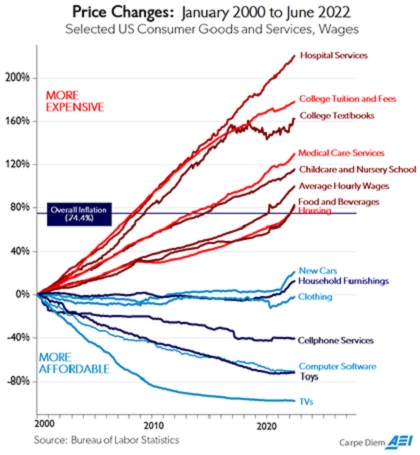
Where will AI fall on the “chart of the century”
- Stephen McBride
- |
- May 1, 2023
- |
- Comments
This article appears courtesy of RiskHedge.
This is the greatest threat we face to innovation… It’s a battle between red and blue… The “chart of the century” tells it all… It’s “game over” if we invite the bureaucrats in…
Orrin Hatch was baffled.
In 2018, Congress grilled Facebook (META) CEO Mark Zuckerberg for 10 hours.
Senator Orrin Hatch demanded to know how Facebook pays the bills when it’s free to use.
Zuckerberg answered Hatch with a smirk:
“Senator, we run ads.”
Bureaucrats barely understood how social media companies worked…
- And now they want to control artificial intelligence (AI).
If you’ve been following RiskHedge Report, you know all about ChatGPT.
The AI chatbot gained 100 million users in just two months. That makes it the fastest-growing app, product, or business in history.
It’s caught Washington’s attention, too. Axios recently reported Senator Chuck Schumer is spearheading the US government’s effort to regulate AI.
Last Friday, I explained why Elon Musk’s recent call to pause “giant AI experiments” for six months would kill innovation. But that’s not the only reason you should oppose it.
A pause would invite the bureaucrats and politicians in. And as I’ll show you, that’s like committing innovation suicide.
- It’s a battle between red and blue…
No, not Republicans versus Democrats…
I’m talking about “regulated” vs. “innovated” industries.
Take a look at this graph. I call it the “chart of the century.” It tracks changes in the prices of 14 everyday goods and services (plus wages) going back to 2000.
 Source: aei.org
Source: aei.org
You can see healthcare, college, and childcare costs (in red) are surging faster than anything else.
What do these three industries have in common? They’re each heavily regulated, or as I like to call them: “Playgrounds for bureaucrats and politicians.”
Government healthcare spending topped $4 trillion last year. Another couple hundred billion dollars has been plowed into education. And over 90% of the $1.75 trillion in outstanding student debt is funded by Uncle Sam.
- Here’s why “regulated” industries go backward.
Technology is forbidden.
Healthcare and education are two of America’s largest industries. Combined, they’re worth trillions of dollars a year.
Savvy entrepreneurs have tried to crack these markets before. Problem is, innovation is essentially illegal in these industries.
Joe Lonsdale, billionaire co-founder of Palantir, gave a great example of this:
“The American Medical Association will lobby against using AI… against any new way of doing things more efficiently. My friend is an allergist. There’s a huge shortage of allergists in the Bay Area. He could see 20 times as many patients by building some basic tech. He’s not allowed to do that. It’s against the law! Any other industry he’d be 20X more productive, bring the cost down and everyone would get treated.”
Compare this to “innovated” industries (in blue) in the above chart.
These sectors are mostly free from government interference. Technology is allowed to flourish. The TV you buy today is better and likely cheaper than the one you bought a decade ago.
I remember about 20 years ago, my uncle came home with a 32-inch “flat screen” TV. As a kid who grew up playing video games on clunky box TVs, this was like something from another dimension. Price tag: $1,500.
Today, you can pick up a flat-screen TV at Walmart that’s double the size for less than half the price.
At this rate, we’ll live in a world where a TV that covers your entire wall costs $100, but a four-year college degree will set you back $1 million. It’s like living in two separate economies.
- Where will AI fall on the “chart of the century?”
Elon Musk’s call to pause “giant AI experiments” is one of the worst ideas I’ve ever heard.
It’s like if Jeff Bezos and Google’s (GOOGL) Larry Page had called for a “ceasefire” on internet progress in the early ’90s.
The announcement invites bureaucrats and politicians to start concocting new regulations. “These AI nerds are crying out for rules; let’s give ‘em what they want.”
It’s blood in the water. Before you know it, government sharks will start circling, trying to bite off their pound of flesh.
The open letter Musk and 1,100 others signed says: “If such a pause cannot be enacted quickly, governments should step in and institute a moratorium.”
Do you expect the same bureaucrats who brought you a student loan crisis… broke the healthcare system… and racked up $30 trillion in federal debt to get AI regulations right?
Many of them don’t even understand how social media companies—and internet advertising—works!
Technology makes things better… faster… and cheaper. We get more for less. TVs are the perfect example.
But every heavily regulated industry is “anti-technology.” We get less for more.
- Can AI pull off an internet-like “great escape?”
The internet has been the greatest moneymaking machine of our lifetimes.
Six of the 10 largest companies in the world—worth a combined $8 trillion—built their fortunes on the back of the web.
Most of America’s rich elite also made their vast fortunes from the internet. It showered stock market investors with profits, too.
The web was a bastion of innovation and wealth because the government largely left it alone and let it flourish. You didn’t need permission from the government to use it. There were no permits and licenses required to build on top of it.
Even when regulators enacted laws in the mid-’90s, they took a hands-off approach.
Now, imagine if politicians had drafted the 500-page “Internet Act” just as the web was taking off.
You couldn’t have predicted Google, Facebook, or Uber (UBER) in the early ’90s. So how could you pass laws to regulate them? In fact, I bet the “Internet Act” would have included some silly rules killing these companies before they were even born.
AI is one of the most powerful disruptions of our lifetimes. It has the potential to be as big as the internet.
But if we pause and invite the bureaucrats in, it’s “game over.” Innovation would be illegal, just like it is in healthcare and education.
Once politicians sink their teeth in, you can forget about resuming progress after six months. As the great Milton Friedman once said, “Nothing is so permanent as a temporary government program.”
Stephen McBride
Chief Analyst, RiskHedge
PS: If you missed my recent discussion on AI with RiskHedge Chief Investment Officer Chris Wood, go here now (or click the image below).
We cover the best ways to act on the AI revolution. And Chris shares details on what he believes is the most immediately lucrative investing opportunity in AI. It’s a tiny stock (under $2/share) using AI to analyze satellite imagery…
|

This article appears courtesy of RH Research LLC. RiskHedge publishes investment research and is independent of Mauldin Economics. Mauldin Economics may earn an affiliate commission from purchases you make at RiskHedge.com
